Regional Crustal Vertical Deformation Driven by Terrestrial Water Load Depending on CORS Network and Environmental Loading Data: A Case Study of Southeast Zhejiang
Abstract
:1. Introduction
2. Materials and Methods
2.1. Data Used in Comprehensive Calculation
2.1.1. CORS Network Data
2.1.2. Atmosphere Pressure Data
2.1.3. MSLA Data
2.1.4. GLDAS Model
2.2. GRACE Data and Post-Processing
2.3. Method
3. Results and Analysis
4. Comparison between CORS and GRACE Results
5. Conclusions
- The effect of terrestrial water load on the crust vertical deformation in southeast Zhejiang from 2015 to 2017 reaches the centimeter scale, the amplitude changes from −1.8 cm to 2.4 cm, and the seasonal variation is obvious. In addition, among the three kinds of environmental load, the effect on crustal vertical deformation of atmospheric load is the greatest, at −7~7 mm;
- The spatial distribution of the terrestrial water load effect in the study area from 2015 to 2017 takes the ladder form from the inland to coastal regions, and considering most of the 38 CORS sites, the amplitude change in the west is higher than that in the east. The surface vertical deformation caused by groundwater load change in the east–west–south–north–central sub-regions shows obvious fluctuations;
- The vertical deformation of terrestrial water load based on the comprehensive calculation of the CORS network can reflect spatial–temporal characteristics more precisely than GRACE. The signal strength of GRACE’s monitoring results has no significant effect on the spatial distribution, while the results derived from the CORS network show that a stronger signal in the west than in the east. As regards temporal distribution, the amplitude change in GRACE’s monitoring results over three years is significantly smaller than that of CORS, and there are significant differences between the two sets of results in individual months, especially in November 2015 and January and February 2016;
- GRACE’s monitoring results contain a two-month phase delay compared with the CORS network at all the 38 CORS sites. After correcting the phase delay, the correlation coefficient between the two results was significantly improved. This indicates that CORS station can respond to the vertical displacement of terrestrial water load in a more timely manner than GRACE. GRACE is limited by its spatial resolution, and it struggles to identify details at such spatial scales as those employed in the study area; there is little distinction between sites in the GRACE data. This is the essence of the value of the GNSS, as it helps us to see local effects that may not be captured by GRACE.
Author Contributions
Funding
Institutional Review Board Statement
Informed Consent Statement
Data Availability Statement
Acknowledgments
Conflicts of Interest
Appendix A. Experimental Results of Other CORS Stations
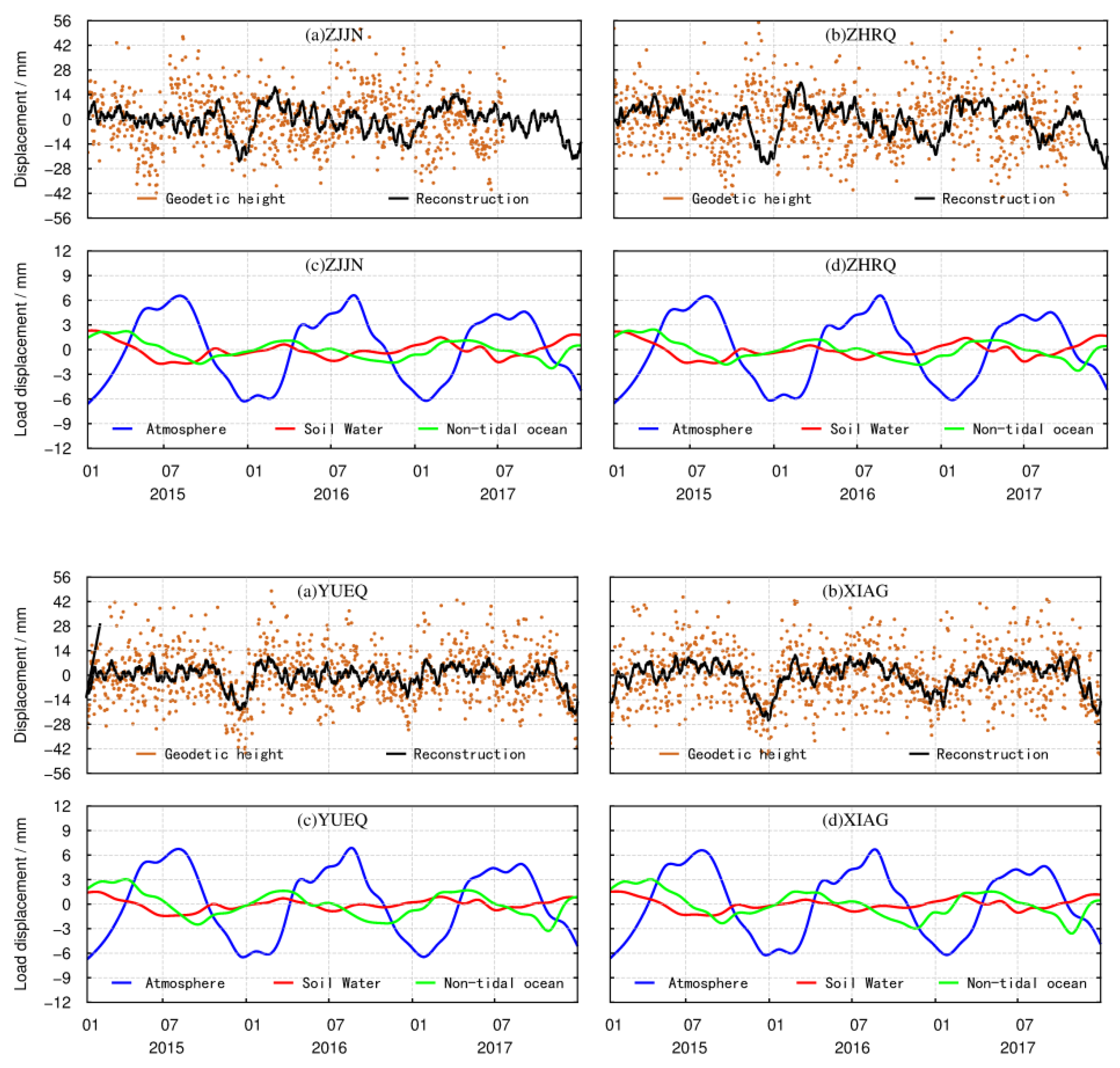

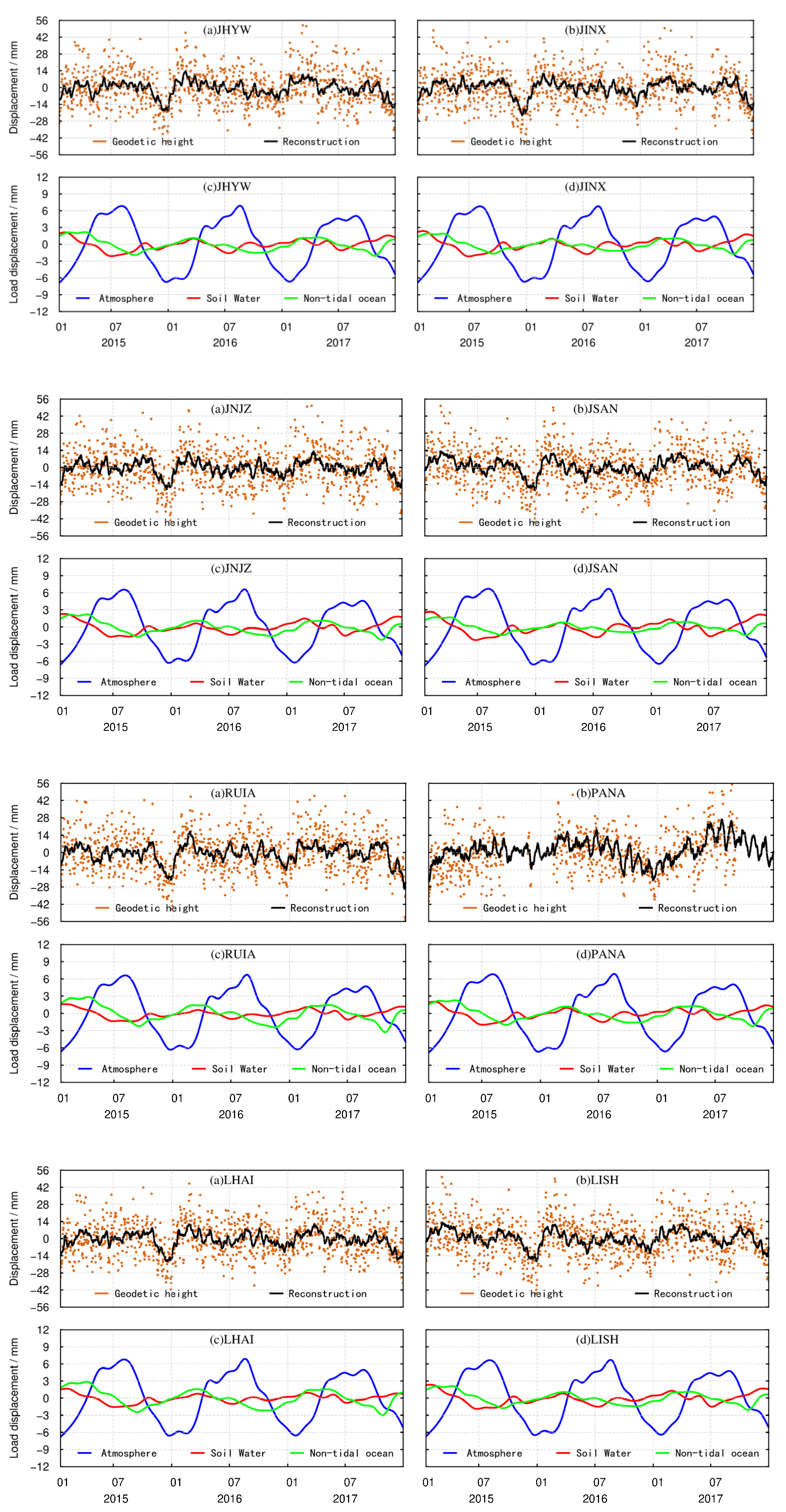
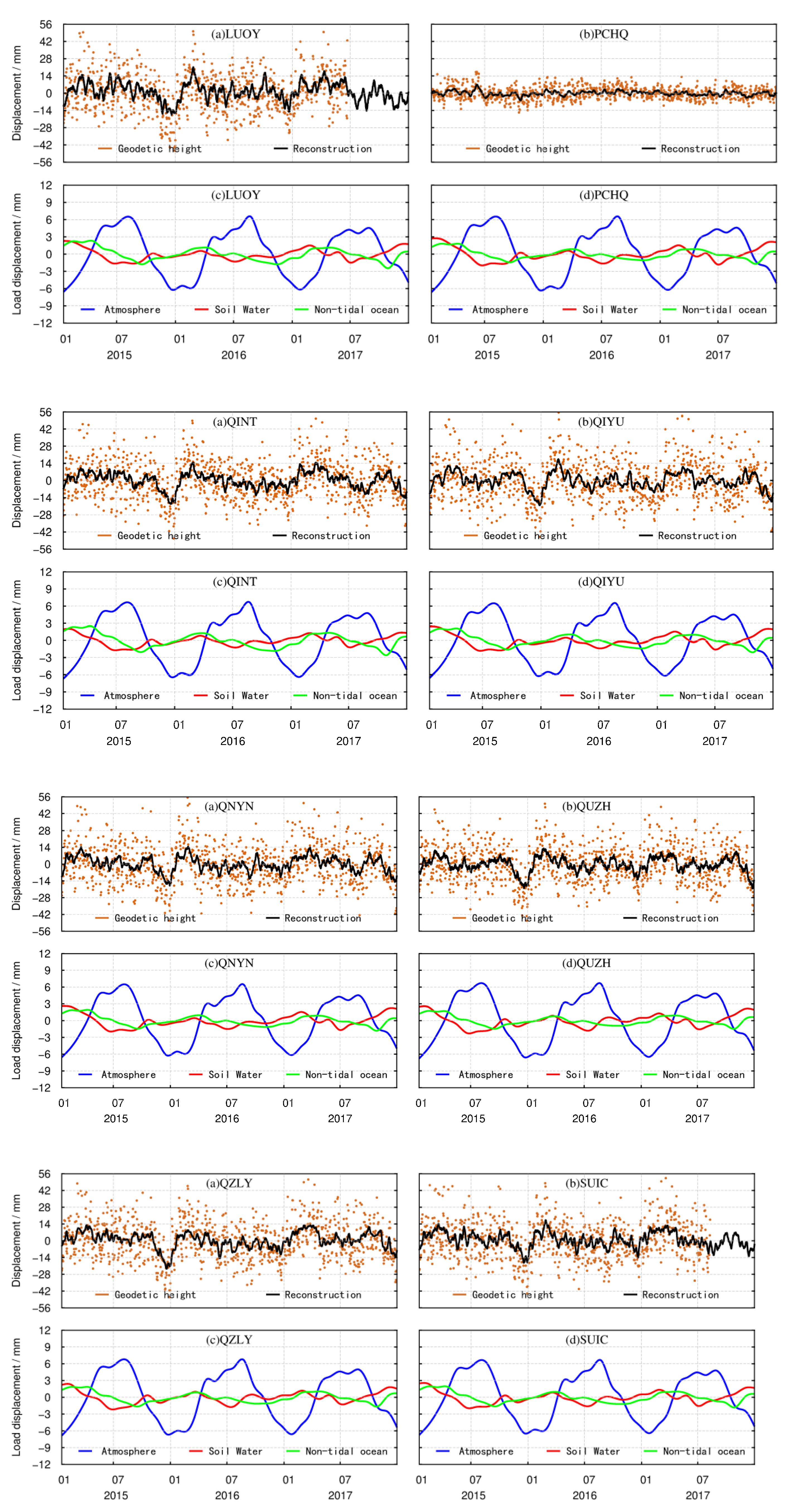




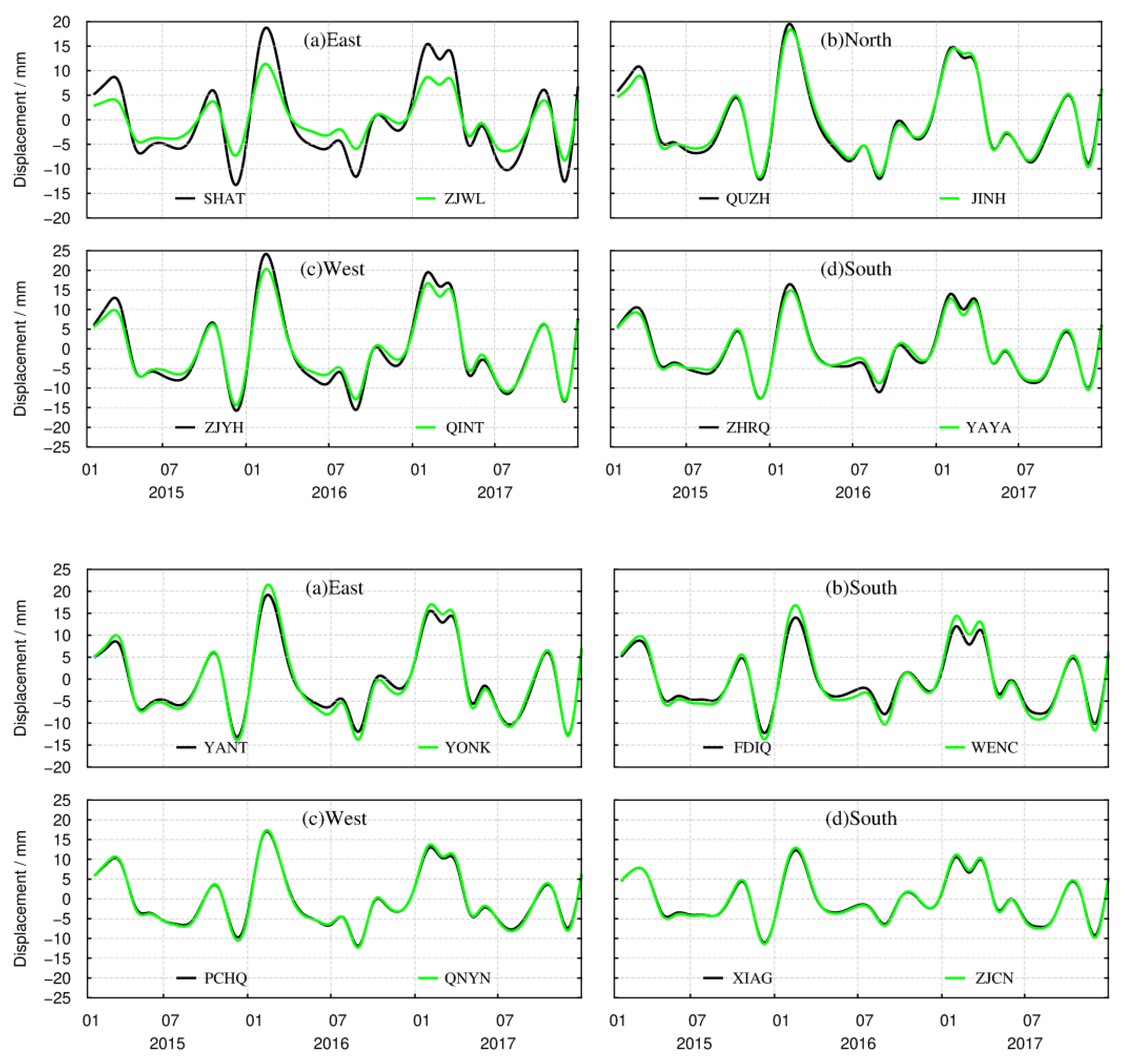
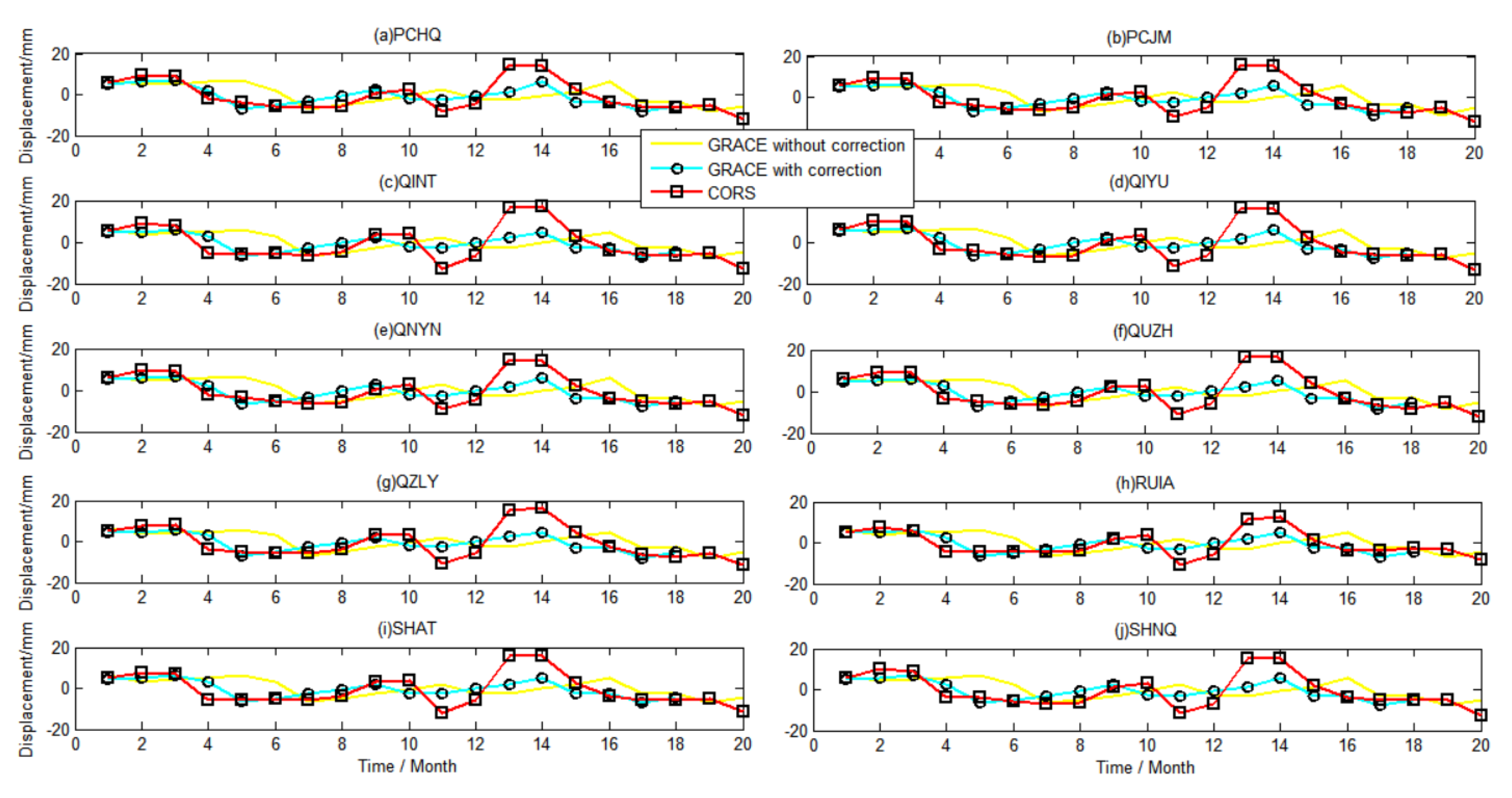
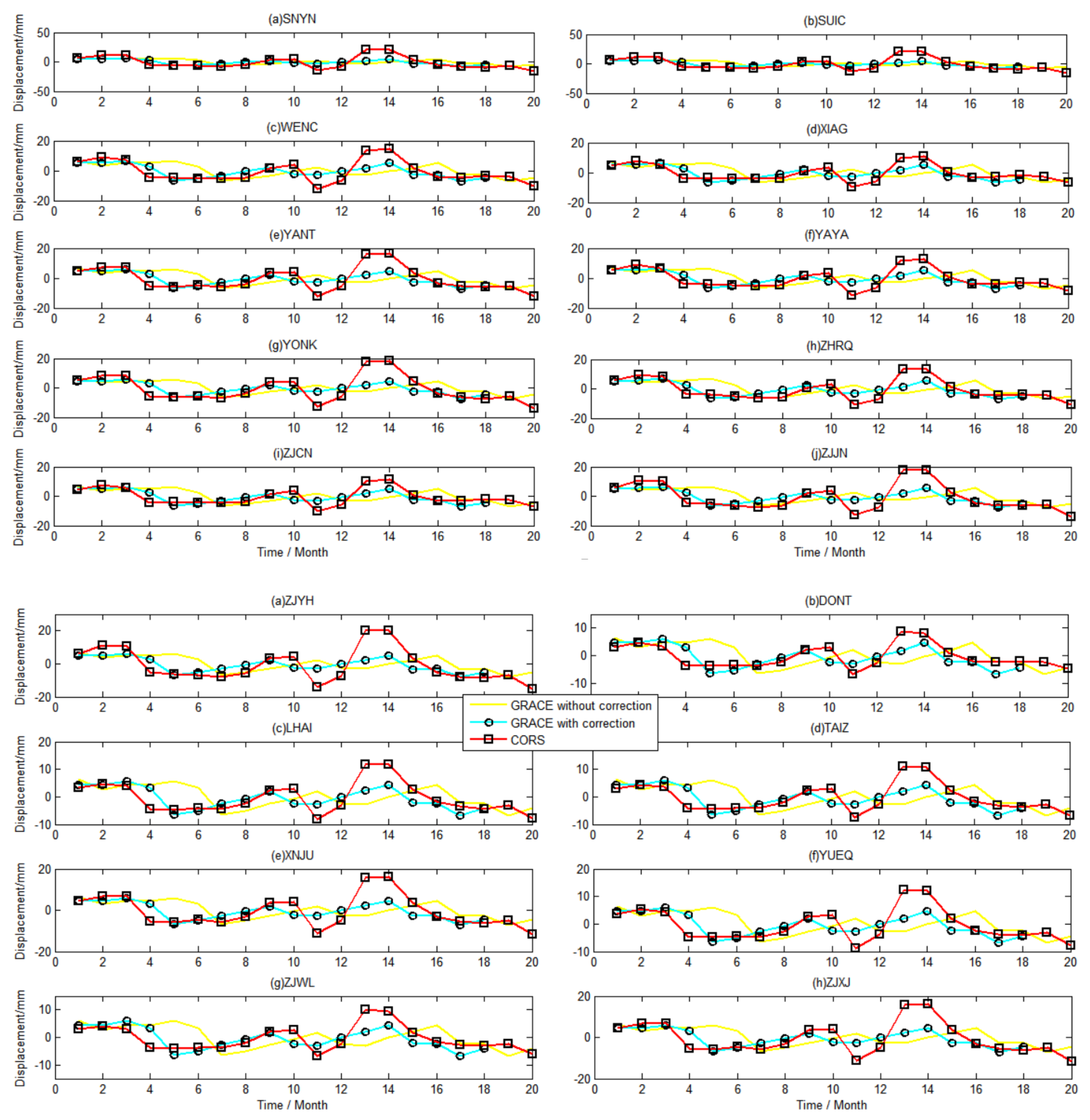
References
- Feng, W.; Jean-Michel, L.; Zhong, M. Terrestrial water storage changes in the Amazon basin measured by GRACE during 2002–2010. Chin. J. Geophys. 2012, 55, 814–821. (In Chinese) [Google Scholar]
- Zheng, C.; Liu, J.; Cao, G. Can China cope with its water crisis?—perspectives from the North China Plain. Groundwater 2010, 48, 350–354. [Google Scholar] [CrossRef]
- Han, S. Elastic deformation of the Australian continent induced by seasonal water cycles and the 2010–2011 La Niña determined using GPS and GRACE. Geophys. Res. Lett. 2017, 44, 2763–2772. [Google Scholar] [CrossRef]
- Liu, R.; Li, J.; Fok, H. Earth Surface Deformation in the North China Plain Detected by Joint Analysis of GRACE and GPS Data. Sensors 2014, 14, 19861–19876. [Google Scholar] [CrossRef] [Green Version]
- Rodell, M.; Famiglietti, J.S. An analysis of terrestrial water storage variations in Illinois with implications for the Gravity Recovery and Climate Experiment (GRACE). Water Resour. Res. 2001, 37, 1327–1339. [Google Scholar] [CrossRef] [Green Version]
- Swenson, S.; Wahr, J. Methods for inferring areal surface-mass anomalies from Gravity Recovery and Climate Experiment (GRACE) measurements of time-variable gravity. J. Geophys. Res. (Solid Earth) 2002, 107, 13. [Google Scholar] [CrossRef] [Green Version]
- Fan, Q.; Zhu, Y. A novel GNSS displacement feature extraction method based on ensemble improved LMD threshold denoising. J. Appl. Geod. 2020, 14, 445–453. [Google Scholar] [CrossRef]
- Manevich, A.I.; Kaftan, V.I.; Losev, I.V.; Shevchuk, R.V. Improvement of the displacement GNSS Monitoring Network of the Nizhne-Kansk Massif Underground Research Laboratory Site. Seism. Instrum. 2021, 57, 587–599. [Google Scholar] [CrossRef]
- Bevis, M.; Alsdorf, D.; Kendrick, E. Seasonal fluctations in the mass of the Amazon River system and Earth’s elastic response. Geophys. Res. Lett. 2005, 32, L16308. [Google Scholar] [CrossRef] [Green Version]
- Van Dam, T.; Wahr, J.; Lavallée, D. A comparison of annual vertical crustal displacements from GPS and Gravity Recovery and Climate Experiment (GRACE) over Europe. J. Geophys. Res. Solid Earth 2007, 112, 1–10. [Google Scholar] [CrossRef] [Green Version]
- Dong, D.; Fang, P.; Bock, Y. Anatomy of apparent seasonal variations from GPS-derived site position time series. J. Geophys. Res. Solid Earth 2002, 107, 9–16. [Google Scholar] [CrossRef] [Green Version]
- Jiang, W.P.; Zhao, L.I.; Liu, H.F. Cause Analysis of the Non-Linear Variations of the IGS Reference Station Coordinate Time Series in China. Chin. J. Geophys. 2013, 56, 340–351. [Google Scholar]
- Yan, H.M.; Chen, W.; Zhu, Y.Z. Contributions of thermal expansion of monuments and nearby bedrock to observed GPS height changes. Geophys. Res. Lett. 2009, 36, 88–97. [Google Scholar] [CrossRef] [Green Version]
- Davis, J.L. Climate-driven deformation of the solid Earth from GRACE and GPS. Geophys. Res. Lett. 2004, 31, L24605. [Google Scholar] [CrossRef] [Green Version]
- Fu, Y.; Freymueller, J.T. Seasonal and long-term vertical deformation in the Nepal Himalaya constrained by GPS and GRACE measurements. J. Geophys. Res. Solid Earth 2012, 117, 3407. [Google Scholar] [CrossRef]
- Zou, R.; Wang, Q.; Freymueller, J.T. Seasonal Hydrological Loading in Southern Tibet Detected by Joint Analysis of GPS and GRACE. Sensors 2015, 15, 30525–30538. [Google Scholar] [CrossRef]
- Liu, R.; Zou, R.; Li, J.C. Vertical Displacement Driven by Groundwater Storage Changes in the North China Plain Detected by GPS and Obervations. Remote Sens. 2018, 10, 259. [Google Scholar] [CrossRef] [Green Version]
- Wang, W.; Dang, Y.M.; Zhang, C.Y. Monitoring of crustal deformation and gravity variation from terrestrial water loading in the Three Gorges region by the CORS network. Chin. J. Geophys. 2017, 60, 962–971. (In Chinese) [Google Scholar]
- Wang, L.; Chen, C.; Du, J. Detecting seasonal and long-term vertical displacement in the North China Plain using GRACE and GPS. Hydrol. Earth Syst. Sci. 2017, 21, 1–52. [Google Scholar] [CrossRef] [Green Version]
- Zhang, C.Y.; Wang, W.; Gan, W.J. Monitoring temporal and spatial changes of crustal deformation and gravity field caused by environmental load in the Three Gorges Reservoir Region based on CORS network. Geomat. Inf. Sci. Wuhan Univ. 2018, 43, 1287–1294. [Google Scholar]
- Li, S.K. Analysis of extreme climate events and its causes in Yangtze River Delta region. Nanjing Univ. Inf. Sci. Technol. 2014, 70, 116–130. [Google Scholar]
- Shen, Y.W.; Sun, Q.M. Contrast analysis of two Heavy snowfall events in Zhejiang. Meteorol. Mon. 2013, 39, 218–225. [Google Scholar]
- Peng, X.Y.; Kong, Z.L.; Zhang, Z.H. Study on the Discrimination Index of Winter Precipitation in Zhejiang Province. Zhejiang Weather 2015, 37, 1–6. [Google Scholar]
- Guo, Q.H. Analysis of precipitation phase change from two rains to heavy snow. Zhejiang Weather 2016, 37, 1–6. [Google Scholar]
- Wu, Y.; Zhao, F.; Kong, Z.L. Feature analysis of the first snowfall in Zhejiang in 2015 by dual-polarization radar. J. Nanjing Univ. Inf. Sci. Technol. 2018, 10, 493–499. [Google Scholar]
- Baniulis, R.; Galinauskas, K.; Marozas, L.; Paršeliūnas, E.; Petniūnas, M.; Puškorius, V. An Analysis of the Performance and Coordinates Time Series of CORS Network LitPOS. In Proceedings of the 2017 Baltic Geodetic Congress (BGC Geomatics), Gdansk, Poland, 22–25 June 2017. [Google Scholar]
- Dardanelli, G.; Lo Brutto, M.; Pipitone, C. GNSS CORS network of the University of Palermo: Design and first analysis of data. Geogr. Tech. 2020, 15, 43–69. [Google Scholar] [CrossRef]
- Kenyeres, A.; Bellet, J.G.; Bruyninx, C.; Caporali, A.; De Doncker, F.; Droscak, B.; Duret, A.; Franke, P.; Georgiec, I.; Bingley, R.; et al. Regional integration of long-term national dense GNSS network solutions. GPS Solut. 2019, 23, 1–17. [Google Scholar] [CrossRef] [Green Version]
- Petit, G.; Luzum, B. IERS Conventions. International Earth Rotation and Reference Systems Service, IERS Technical Note No. 36; Verlag des Bundesamtes für Kartographie und Geodäsie, Frankfurt am Main: Germany, Frankfurt, 2010. [Google Scholar]
- Dee, D.P.; Uppala, S.M.; Simmons, A.J.; Berrisford, P.; Poli, P.; Kobayashi, S.; Andrae, U.; Balmaseda, M.A.; Balsamo, G.; Bauer, P.; et al. The ERA-Interim reanalysis: Configuration and performance of the data assimilation system. Q. J. R. Meteorol. Soc. 2011, 137, 553–597. [Google Scholar] [CrossRef]
- Save, H.; CSR Level-2 Team. “GRACE RL06 Reprocessing and Results from CSR” EGU2018-10697. In Proceedings of the EGU General Assembly 2012, Vienna, Austria, 7–12 April 2012. [Google Scholar]
- Sheng, C. Characteristics of non-tectonic crustal deformation from surface loads around Chinese mainland and correction model. Recent Dev. World Seismol. 2014, 11, 45–48. [Google Scholar]
- Wang, H.; Xiang, L.; Jia, L.; Jiang, L.; Wang, Z.; Hu, B.; Gao, P. Load Love numbers and Green’s functions for elastic Earth models PREM, iasp91, ak135, and modified models with refined crustal structure from Crust 2.0. Comput. Geosci. 2012, 49, 190–199. [Google Scholar] [CrossRef]
- Hiroko, B.; Rodell, M.; Huang, J. GLDAS Noah Land Surface Model L4 Monthly 0.25 × 0.25 Degree V2. 1. Goddard Earth Sci. Data Inf. Serv. Cent. (GES DISC) 2020. [Google Scholar] [CrossRef]
- Lenczuk, A.; Leszczuk, G.; Klos, A.; Lenczuk, A.; Leszczuk, G.; Klos, A.; Kosek, W.; Bogusz, J. Study on the inter-annual hydrology-induced displacements in Europe using GRACE and hydrological models. J. Appl. Geod. 2020, 14, 393–403. [Google Scholar] [CrossRef]
- Xiong, J.; Yin, J.; Guo, S.; Slater, L. Continuity of terrestrial water storage variability and trends across mainland China monitored by the GRACE and GRACE-Follow on satellites. J. Hydrol. 2021, 599, 126308. [Google Scholar] [CrossRef]
- Li, J.; Chen, J.L.; Wilson, C.R. Topographic effects on coseismic gravity change for the 2011 Tohoku-Oki earthquake and comparison with GRACE. J. Geophys. Res. Solid Earth 2016, 121, 5509–5537. [Google Scholar] [CrossRef]
- Matsuo, K.; Heki, K. Coseismic and postseismic gravity changes of the 2011 Tohoku-Oki Earthquake from satellite gravimetry. AGU Fall Meet. Abstr. 2011, 2011, G51A-0872. [Google Scholar]
- Swenson, S.; Chambers, D.; Whar, J. Estimating geocenter variations from a combination of GRACE and ocean model output. J. Geophys. Res. 2008, 113, 8. [Google Scholar] [CrossRef] [Green Version]
- Farrell, W.E. Deformation of the Earth by surface loads. Rev. Geophys. 1972, 10, 761–797. [Google Scholar] [CrossRef]
- Argus, D.F.; Fu, Y.; Landerer, F.W. Seasonal variation in total water storage in California inferred from GPS observations of vertical land motion. Geophys. Res. Lett. 2014, 41, 1971–1980. [Google Scholar] [CrossRef]
- Long, D.; Yang, Y.; Wada, Y. Deriving scaling factors using a global hydrological model to restore GRACE total water storage changes for China’s Yangtze River Basin. Remote Sens. Environ. 2015, 168, 177–193. [Google Scholar] [CrossRef]
- Van Beek, L.P.H.; Wada, Y.; Bierkens, M.F.P. Global monthly water stress: 1. Water balance and water availability. Water Resour. Res. 2011, 47, w07517. [Google Scholar] [CrossRef]
- Wada, Y.; van Beek, L.P.; van Kempen, C.M.; Reckman, J.W.; Vasak, S.; Bierkens, M.F. Global depletion of groundwater resources. Geophys. Res. Lett. 2010, 37, L20402. [Google Scholar] [CrossRef] [Green Version]
- Wada, Y.; Wisser, D.; Bierkens, M.F.P. Global modeling of withdrawal, allocation and consumptive use of surface water and groundwater resources. Earth Syst. Dyn. 2014, 5, 15–40. [Google Scholar] [CrossRef] [Green Version]
- Li, W.; Wang, W.; Zhang, C.; Wen, H.; Zhong, Y.; Zhu, Y.; Li, Z. Bridging terrestrial water storage anomaly during GRACE/GRACE-FO gap using SSA method: A case study in China. Sensors 2019, 19, 4144. [Google Scholar] [CrossRef] [PubMed] [Green Version]
- Zhong, Y.; Zhong, M.; Mao, Y.; Ji, B. Evaluation of Evapotranspiration for Exorheic Catchments of China During the GRACE Era: From a Water Balance Perspective. Remote Sens. 2020, 12, 511. [Google Scholar] [CrossRef] [Green Version]
- Yao, G.; Yilmaz, A.; Zhang, L.; Meng, F.; Ai, H.; Jin, F. Matching large baseline oblique stereo images using an end-to-end convolutional Neural network. Remote Sens. 2021, 13, 274. [Google Scholar] [CrossRef]
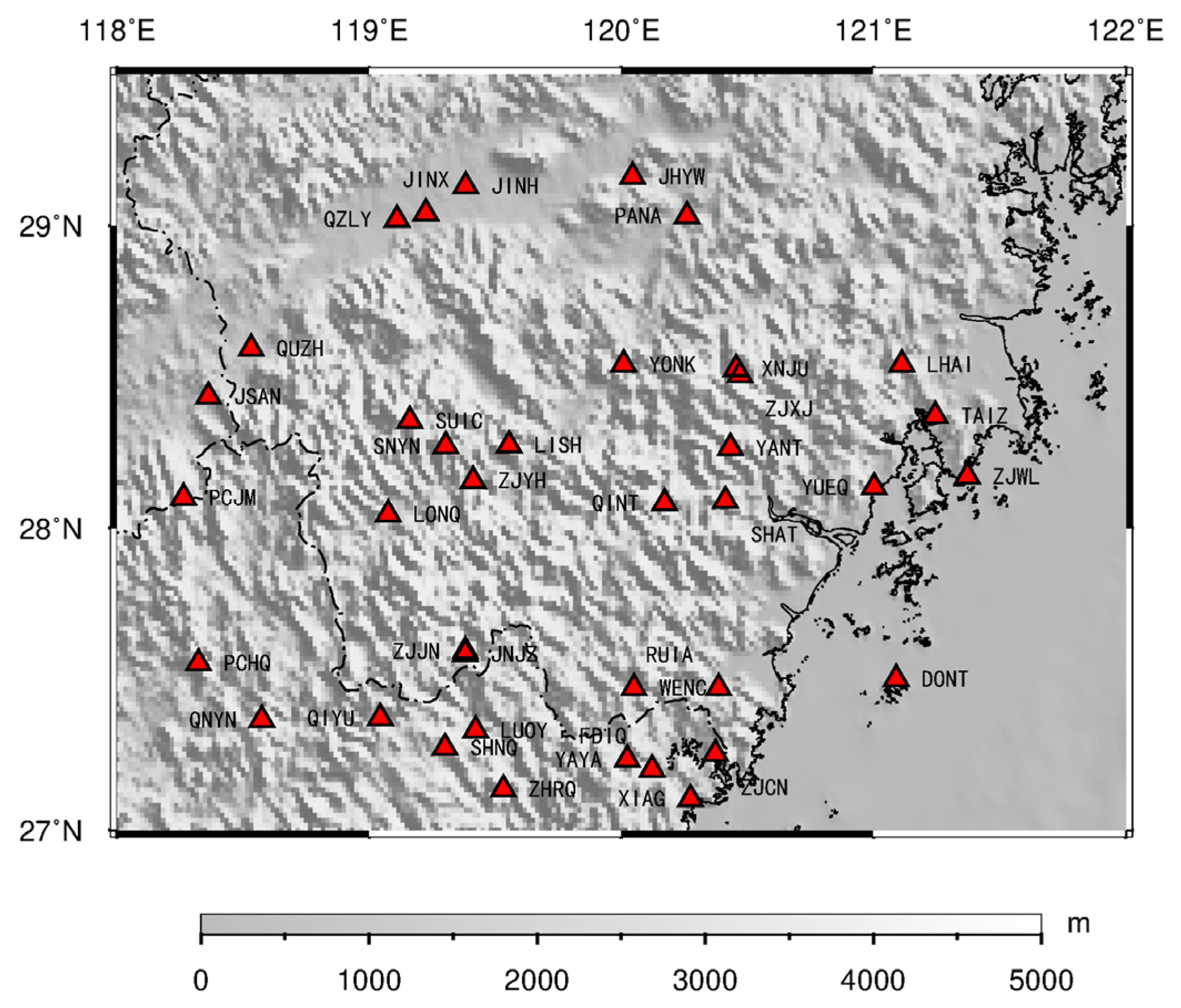


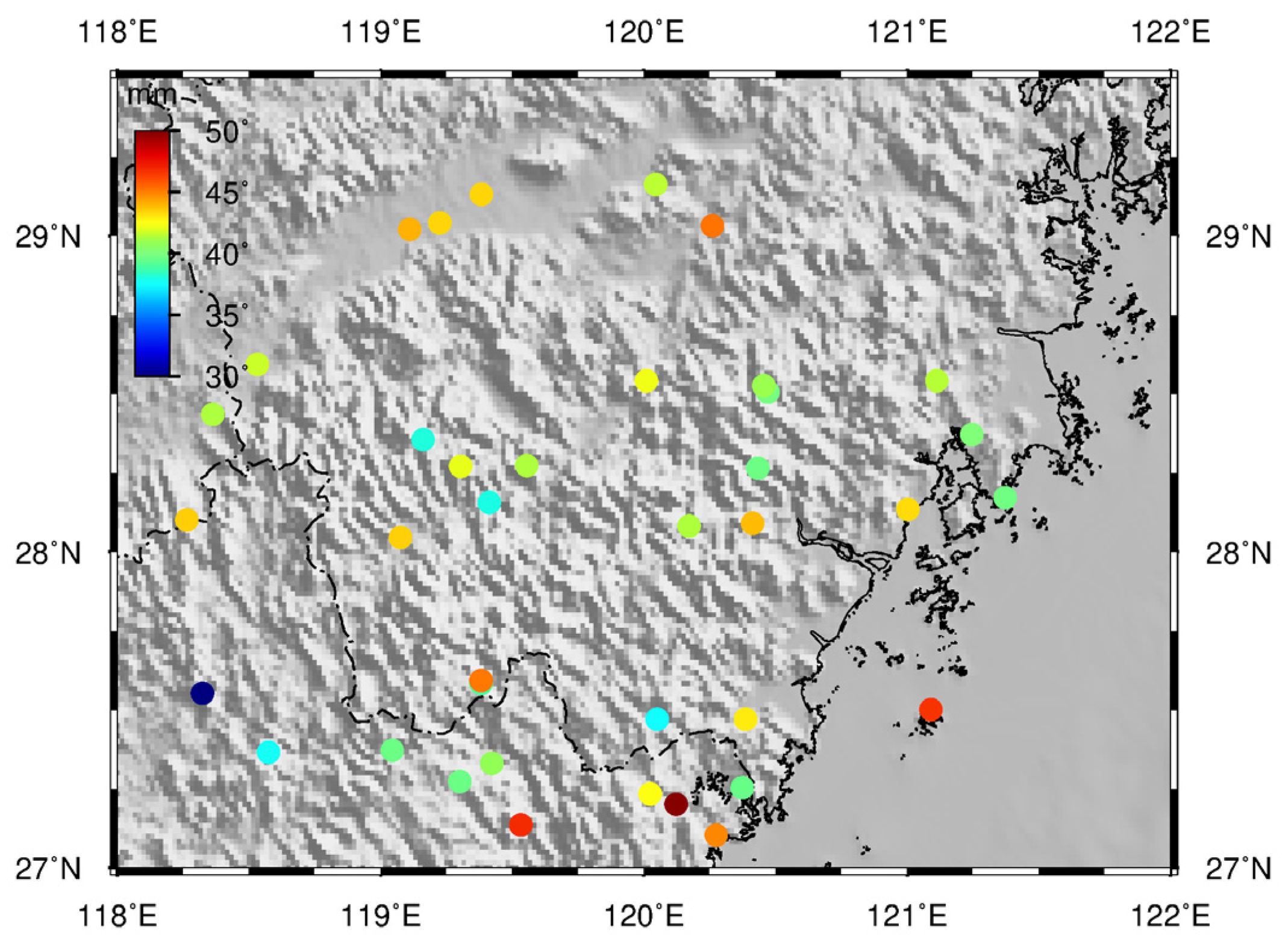


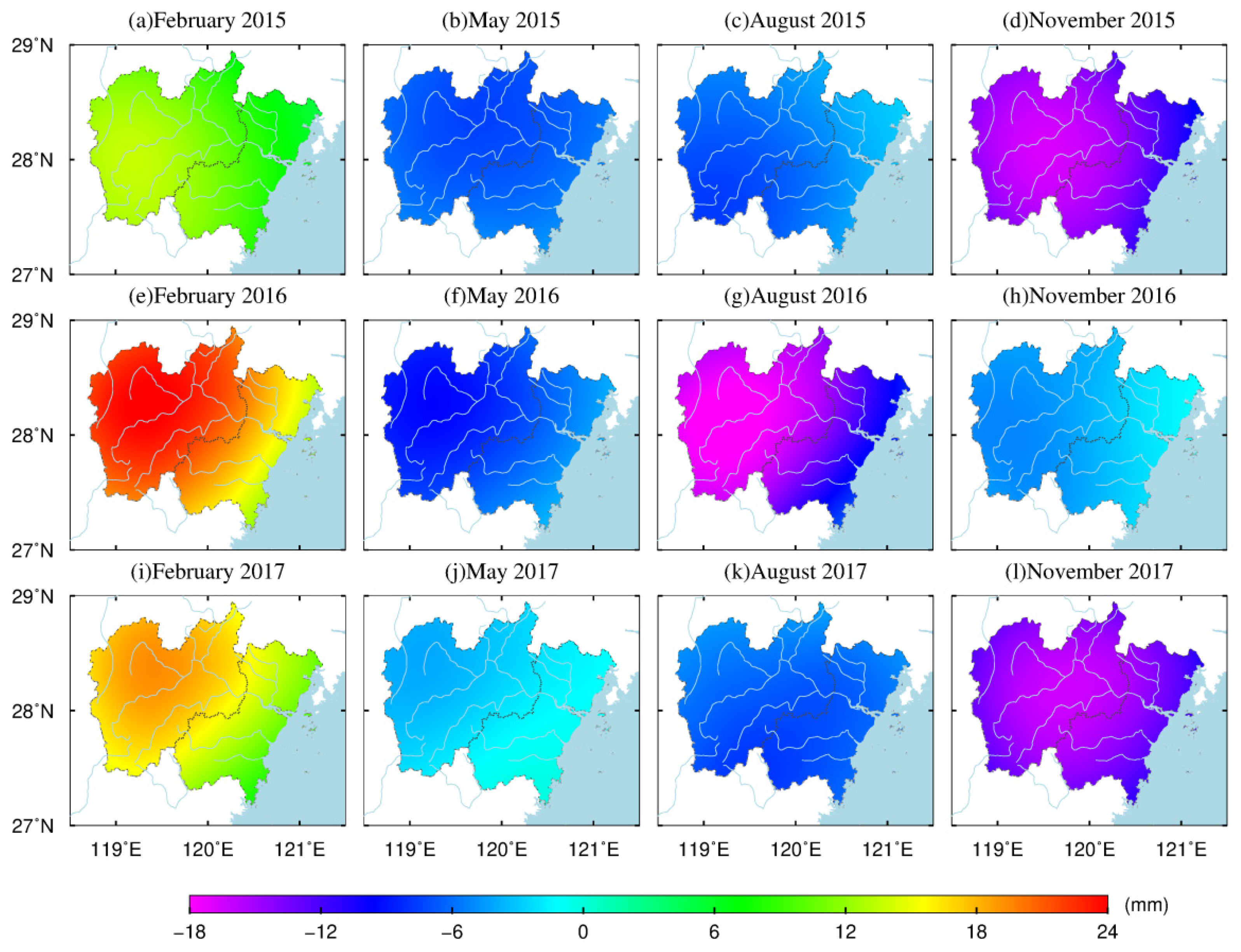

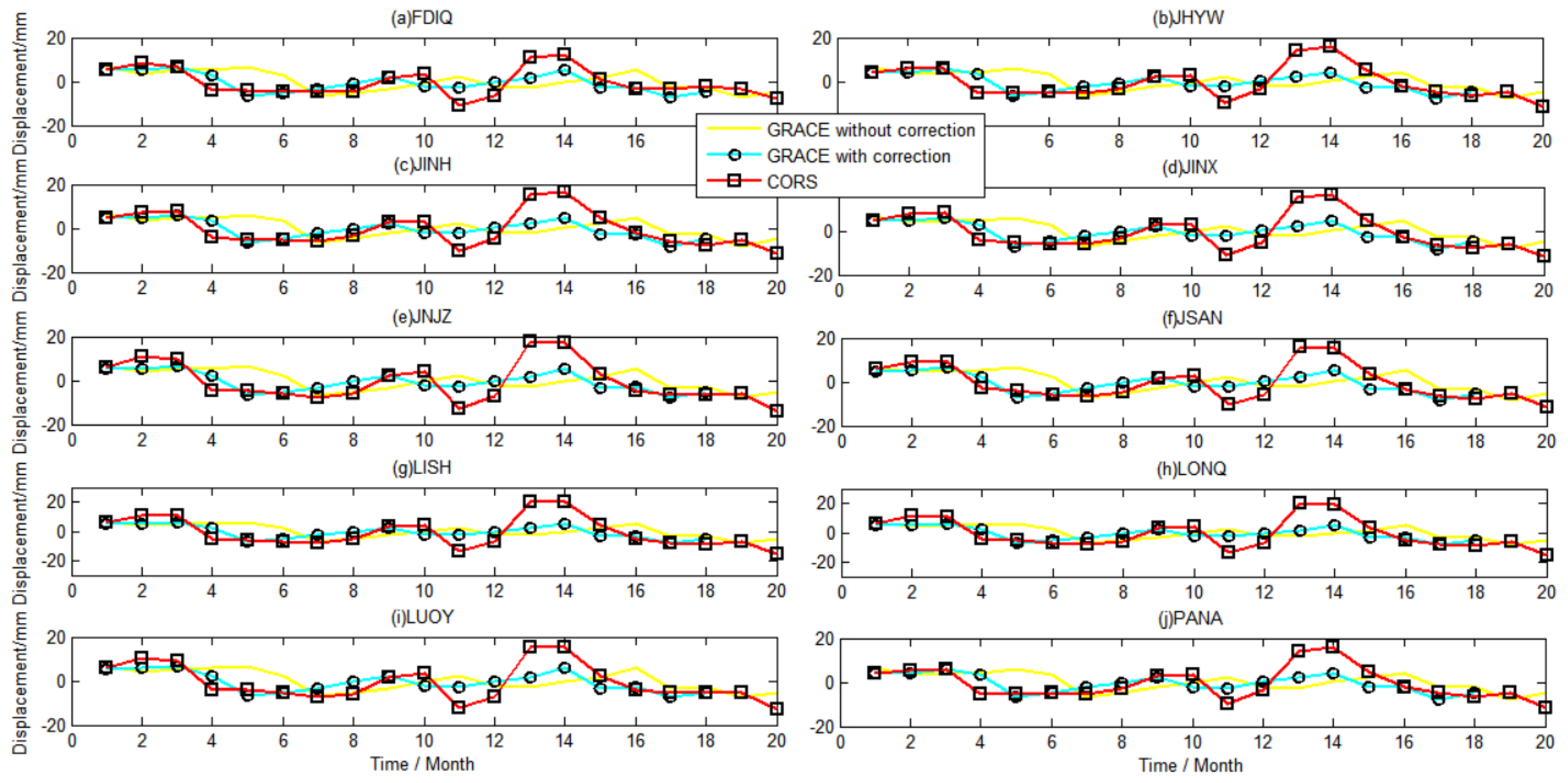
| Parameter | Processing Mode |
|---|---|
| Sampling interval data | 15 s |
| Satellite cut-off elevation angle (°) | 10 |
| Baseline processing mode | BASELINE |
| Ionosphere delay model | LC_AUTCLN |
| Satellite clock error model | Precise clock offset and orbit products of IGS |
| Tropospheric model | Saastamoinen + GPT2w + estimation |
| Solar radiation pressure model | ECOMC model |
| Solid tide model | IERS2010 |
| Ocean tide model | FES2004(otl_FES2004.grid) |
| Atmospheric mapping function | VMF1 |
| Inertial framework | J2000 |
| Framework of prior coordinates | ITRF2014 |
| PCO/PCV | IGS14 atx |
| Ambiguity resolution | LAMBDA method |
| IGS station priori coordinates | The coordinates under ITRF2008 published by SOPAC |
| Site | Longitude and Latitude | Site | Longitude and Latitude | Site | Longitude and Latitude |
|---|---|---|---|---|---|
| AIRA | 130.5995 31.8240 | ARTU | 58.5604 56.4298 | BJFS | 115.8924 39.6086 |
| DAEJ | 127.3744 36.3994 | LHAZ | 91.1040 29.6573 | PIMO | 121.0777 14.6357 |
| POL2 | 74.6942 42.6797 | SHAO | 121.2004 31.0996 | TCMS | 120.9873 24.7979 |
| WUHN | 87.6006 43.8079 | URUM | 114.3572 30.5316 | YSSK | 142.7167 47.0297 |
| Site Name | Weight | Site Name | Weight | Site Name | Weight | Site Name | Weight |
|---|---|---|---|---|---|---|---|
| DONT | 0.8 | LUOY | 1.0 | SHAT | 1.0 | YAYA | 1.0 |
| FDIQ | 0.8 | PANA | 0.8 | SHNQ | 1.0 | YONK | 1.0 |
| JHYW | 1.0 | PCHQ | 0.8 | SNYN | 1.0 | YUEQ | 1.0 |
| JINH | 1.0 | PCJM | 0.8 | SUIC | 1.0 | ZHRQ | 1.0 |
| JINX | 1.0 | QINT | 1.0 | TAIZ | 1.0 | ZJCN | 1.0 |
| JNJZ | 1.0 | QIYU | 1.0 | WENC | 0.8 | ZJJN | 1.0 |
| JSAN | 1.0 | QNYN | 1.0 | XIAG | 1.0 | ZJWL | 1.0 |
| LHAI | 1.0 | QUZH | 1.0 | XNJU | 1.0 | ZJXJ | 1.0 |
| LISH | 1.0 | QZLY | 1.0 | YANT | 1.0 | ZJYH | 1.0 |
| LONQ | 1.0 | RUIA | 1.0 |
| Station Name | Value | Station Name | Value | Station Name | Value | Station Name | Value |
|---|---|---|---|---|---|---|---|
| FDIQ | 0.69 | JHYW | 0.64 | JINH | 0.68 | JINX | 0.68 |
| JNJZ | 0.71 | JSAN | 0.72 | LISH | 0.70 | LONQ | 0.71 |
| LUOY | 0.71 | PANA | 0.64 | PCHQ | 0.74 | PCJM | 0.73 |
| QINT | 0.68 | QIYU | 0.72 | QNYN | 0.74 | QUZH | 0.72 |
| QZLY | 0.69 | RUIA | 0.68 | SHAT | 0.67 | SHNQ | 0.71 |
| SNYN | 0.71 | SUIC | 0.71 | WENC | 0.69 | XIAG | 0.68 |
| YANT | 0.67 | YAYA | 0.69 | YONK | 0.66 | ZHRQ | 0.71 |
| ZJCN | 0.68 | ZJJN | 0.71 | ZJYH | 0.71 | DONT | 0.67 |
| LHAI | 0.64 | TAIZ | 0.64 | XNJU | 0.66 | YUEQ | 0.65 |
| ZJWL | 0.64 | ZJXJ | 0.66 |
Publisher’s Note: MDPI stays neutral with regard to jurisdictional claims in published maps and institutional affiliations. |
© 2021 by the authors. Licensee MDPI, Basel, Switzerland. This article is an open access article distributed under the terms and conditions of the Creative Commons Attribution (CC BY) license (https://creativecommons.org/licenses/by/4.0/).
Share and Cite
Li, W.; Dong, J.; Wang, W.; Wen, H.; Liu, H.; Guo, Q.; Yao, G.; Zhang, C. Regional Crustal Vertical Deformation Driven by Terrestrial Water Load Depending on CORS Network and Environmental Loading Data: A Case Study of Southeast Zhejiang. Sensors 2021, 21, 7699. https://doi.org/10.3390/s21227699
Li W, Dong J, Wang W, Wen H, Liu H, Guo Q, Yao G, Zhang C. Regional Crustal Vertical Deformation Driven by Terrestrial Water Load Depending on CORS Network and Environmental Loading Data: A Case Study of Southeast Zhejiang. Sensors. 2021; 21(22):7699. https://doi.org/10.3390/s21227699
Chicago/Turabian StyleLi, Wanqiu, Jie Dong, Wei Wang, Hanjiang Wen, Huanling Liu, Qiuying Guo, Guobiao Yao, and Chuanyin Zhang. 2021. "Regional Crustal Vertical Deformation Driven by Terrestrial Water Load Depending on CORS Network and Environmental Loading Data: A Case Study of Southeast Zhejiang" Sensors 21, no. 22: 7699. https://doi.org/10.3390/s21227699
APA StyleLi, W., Dong, J., Wang, W., Wen, H., Liu, H., Guo, Q., Yao, G., & Zhang, C. (2021). Regional Crustal Vertical Deformation Driven by Terrestrial Water Load Depending on CORS Network and Environmental Loading Data: A Case Study of Southeast Zhejiang. Sensors, 21(22), 7699. https://doi.org/10.3390/s21227699






